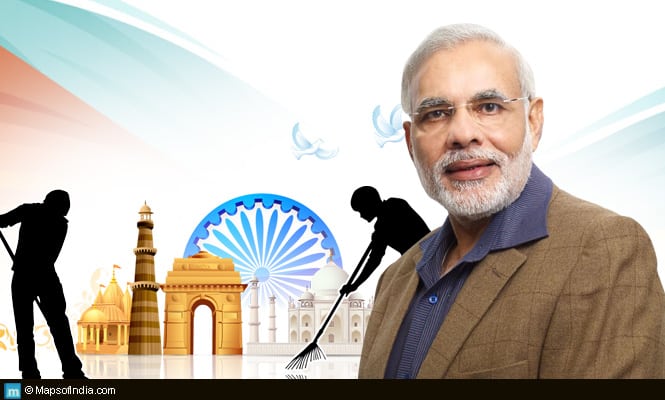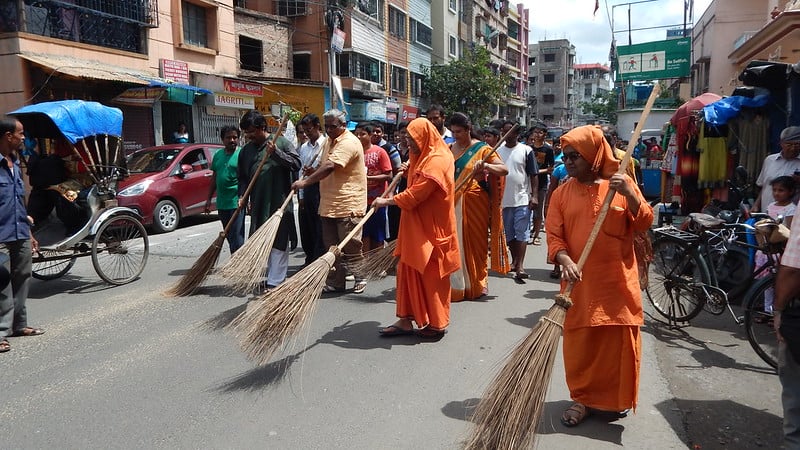It is unbelievable. The otherwise dirty cities of India, with garbage piling up everywhere, have become visibly cleaner. Plenty of new public washrooms have been built everywhere. The change is visible within only a few months. It seems that India is undergoing some huge transformation. But what happened actually? In 2014, Indian Prime Minister Narendra Modi launched the “Clean India, Green India”(Swachh Bharat) sanitation program, and Indian towns started to compete with great enthusiasm for the “Open Defecation Free (ODF)” title. Clean India Green India drawings and slogans are painted everywhere. So let’s see how the program worked out all in all.
The Clean India Green India mission
After his election in 2014, Modi drew the attention of the whole country to the importance of cleanliness. He decided that by the 150th anniversary of the birth of Mahatma Gandhi, i.e. by 2nd October 2019, every home would have restrooms, clean drinking water, and sanitation. The Clean India Green India initiative is the best way to pay homage to the Father of the Indian nation. In 1925, Mahatma Gandhi said that hygiene is more important than independence. Returning home from South Africa, he was astonished at how dirty India was, and he quickly became an advocate for improving sanitation in the country.
Read more interesting stories about India
Of course, simply building numerous toilets will not solve the problem if they are not used. As part of the Clean India program, a national campaign was announced to change the misconceptions that especially exist in the countryside.
It is equally important to change the general social behavior and mindset. Many people still thought that a toilet is only for women, children, and the elderly and that it was much healthier to defecate in the open air than in a small enclosed space. Some had never seen a toilet before, while others had trouble using it properly.
On 2nd October 2014, a national holiday in India, the prime minister swept the street himself at Raj Ghat. On the same day, Indian civil servants went to work and officially launched the “Clean India” (Swachh Bharat) program by cleaning up their offices.

However, making the country clean should be the responsibility of all citizens. So Narendra Modi made it clear that anyone can participate in the program. The person needs to take a photo of the dirty place before and after cleaning and then upload it to social media. From the day of the announcement, the participants were eager to upload thousands of before and after pictures.
The Prime Minister called famous athletes, Bollywood actors and businessmen to publicize the program using their popularity.
The biggest toilet program in the world
Before the program, only 4 out of 10 households in the countryside had their toilet. Almost half of the population of India did defecation openly, many along the railway lines. Men on one side, women on the other side, where bushes could provide some intimacy. A government minister once called the vast rail network of the country “the world’s largest open-air toilet.”
This practice involves tons of dangers. Regular crossings of railway lines themselves are a direct danger. Many people died in accidents like this or lost their limbs. Many children suffer from infections caused by contact with feces. In the absence of a secluded, intimate area, girls and women are also much more exposed to harassment and violence. In India, which has poor statistics on female violence anyway, most cases occur when they defecate “in the open”.
The project seemed quite ambitious. More than 60,000 toilets had to be built per day to complete the target of 100 million toilets by 2019. India has invested nearly $ 7 billion.
The initiative was a success. By November 2018, almost 90% of the villages were already free from open defecation. There have been campaigns in the past too, but none have been as effective as these.
Taking the Indian program as an example, the “Clean Nepal Program” was also launched on 3 January 2015 in neighboring Nepal.
The toilet matter was so important that the Bollywood film “Toilet” starring Aksey Kumar came out in 2017 to strengthen the campaign.
Nevertheless, the picture is not completely positive. Some say the officially published statistics are overestimated, and in fact, it would have been unrealistic to produce these figures. Human Rights Watch and other human rights organizations have drawn attention to the fact that those caught defecating in the open have been forcibly forced to use the toilet. This, of course, mainly affects the untouchables at the bottom of the society, who do not have the money to build a toilet and still have to face day-to-day abuse and exclusion from society. If they are caught, it is just a good excuse to “punish” them.
The Slogans of the Clean India Green India project
Read more: https://www.iaspaper.net/swachh-bharat-abhiyan-slogan/



Pingback: 30 interesting facts and stories about India | Voice of Guides